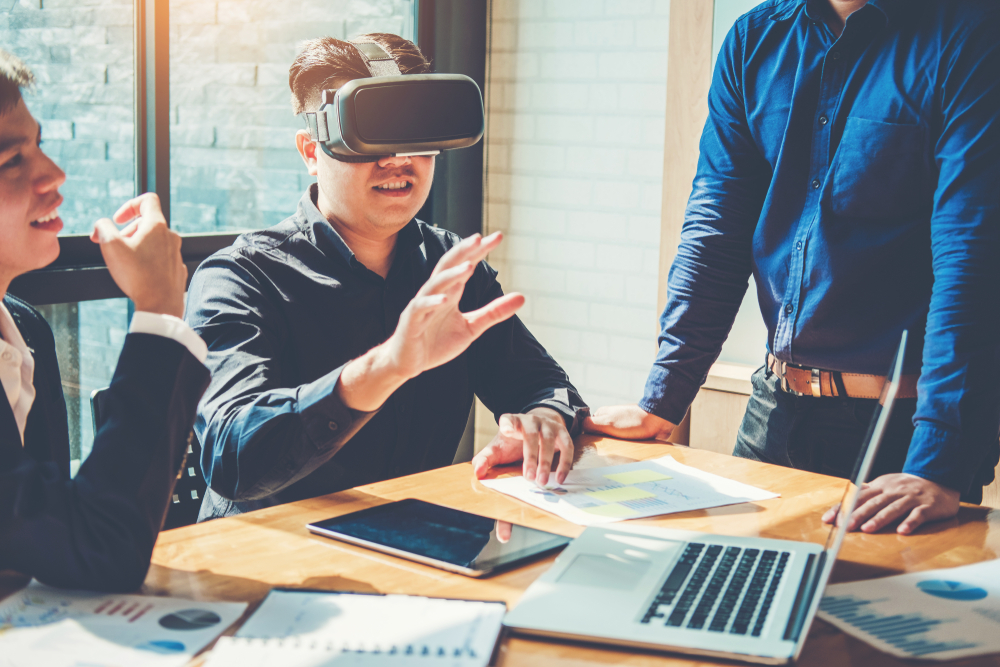Regardless of your industry, training both new and existing employees is a necessity — and the practice hasn’t changed much in the last 100 years or so. We’ve transitioned from books and manuals to digital training tests, but these computer-based alternatives lack the hands-on experience employees need to make the training stick. How could new technology, like virtual and augmented reality, help improve things?

Shutterstock Licensed Photo – By Joyseulay
Improving Employee Training Through VR
Virtual reality creates immersive environments users can utilize for everything from gaming to education and design. Recently, many companies — like Walmart, Volkswagen and NASA — have started adopting VR as a tool for training. How does this new technology help employees learn and retain the skills they’ll need to do their jobs effectively?
Traditional training methods can be useful, but they don’t help employees remember job skills. One study found that employees will forget up to 50% of what they’ve learned within 60 minutes of finishing their training. Virtual reality training can double skill retention. One CEO even found that her employees remembered skills better after a year with VR training than they could in one week without.
Additionally, virtual reality can help new employees learn the skills they’ll need to succeed in a fraction of the time. Chicken restaurant KFC recently rolled out a VR simulation to teach new employees how to make its signature fried chicken. Without VR, this training takes 25-30 minutes. In virtual reality, it only takes 10.
VR training can even entice new job-seekers to choose your company. One of the biggest challenges employers face when it comes to worker retention is that they feel they don’t have enough training or advancement opportunities. About 70 percent of employees surveyed say training and development plays an enormous role in whether they choose to stay with a company.
What Industries Will Benefit From VR Training?
What industries will benefit from implementing virtual reality as part of their training and continuing education model? Nearly all of them, if you look at current trends. We’ve already mentioned examples of this kind of training in the retail and food service industries, but they’re not the only ones adopting this new training technology.
Also Read
The military is using both virtual and augmented reality to train soldiers, engineers and other team members in everything from mission strategies to equipment repair. Law enforcement can train in virtually simulated scenarios that mimic the sounds and sights they’d experience out on the streets.
The manufacturing and logistics industries can use virtual and augmented reality to train employees in a variety of tasks, from repairing damage to superimposing virtual schematics or objects over real-world items. Doctors and surgeons can learn to complete complex procedures and diagnoses before they ever work with live patients. Combined with haptic feedback, these programs can feel nearly as real as working on a live patient or a cadaver.
The construction industry is starting to use VR to train workers on how to handle cranes and other heavy equipment.
This list is just a small sample of all the industries that are slowly integrating virtual reality into their training programs. The only thing holding some businesses back is the problem of cost and the integral fear that always accompanies the adoption of new technologies. What do you need to do to add virtual reality to your current training schedule?
Integrating Virtual Reality Into Your Training Model
Start by taking a look at your current training schedule and figure out what could you could improve with virtual reality. This may not work for every industry, but there may be facets where you can improve training with VR. Journalists, for example, won’t learn to become better writers in virtual reality, but the technology could be used to train them how to respond in high-stress situations.
Next, look at the existing VR training content currently available. Is there a program out that will work for your industry, or will you need to hire someone to design one specifically for your company? The next step is to invest in some VR headsets and a computer to support your training regimen. In the beginning, you may want to consider renting the headsets, as some of them can be extremely expensive. If you’re planning on adopting VR training permanently, it may be more cost-effective to invest in your own VR equipment.
Finally, spend some time monitoring employee productivity in relation to the VR training. This, more than anything else, can tell you if your VR training program is effective, needs some improvement or isn’t helping at all.
The Future of VR Training
Virtual reality isn’t just for video games anymore, nor is it relegated to arcade back rooms and bulky equipment. You can enjoy virtual environments with nothing more than a portable headset and a cellphone. Using virtual reality for training is just starting to take off, but it could potentially change the way new employees are trained when they start a job. As technology continues to advance and becomes more affordable, we may see more industries choosing virtual and augmented reality for training rather than 2D computer-based programs.
While VR is no replacement for traditional hands-on training and experience, it could help bridge the gap between computer and textbook training and actual work. We’ll have to wait and see where the industry goes in the future, but as of right now, it’s looking bright.
